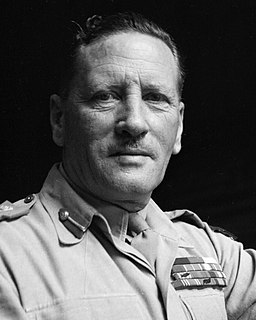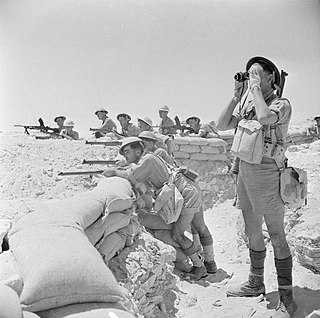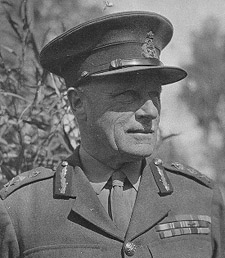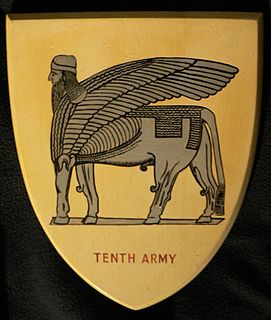
Field Marshal Sir Claude John Eyre Auchinleck,, was a British Army commander during the Second World War. He was a career soldier who spent much of his military career in India, where he rose to become Commander-in-Chief of the Indian Army by early 1941. In July 1941 he was appointed Commander-in-Chief of the Middle East Theatre, but after initial successes, the war in North Africa turned against the British, and he was relieved of the post in 1942 during the crucial Alamein campaign.

The First Battle of El Alamein was a battle of the Western Desert Campaign of the Second World War, fought in Egypt between Axis forces of the Panzer Army Africa and Allied forces of the Eighth Army.

Field Marshal Henry Maitland Wilson, 1st Baron Wilson,, also known as Jumbo Wilson, was a senior British Army officer of the 20th century. He saw active service in the Second Boer War and then during the First World War on the Somme and at Passchendaele. During the Second World War he served as General Officer Commanding-in-Chief (GOC-in-C) British Troops in Egypt, in which role he launched Operation Compass, attacking Italian forces with considerable success, in December 1940. He went on to be Military Governor of Cyrenaica in February 1941, commanding a Commonwealth expeditionary force to Greece in April 1941 and General Officer Commanding (GOC) British Forces in Palestine and Trans-Jordan in May 1941.

IV Corps was a corps-sized formation of the British Army, formed in both the First World War and the Second World War. During the First World War the corps served on the Western Front throughout its existence. During the Second World War it served in Norway and Britain until, after Japan entered the war and India was threatened with attack, it was transferred there.

General Sir Edward Pellew Quinan was a British Army commander during the Second World War. In the early part of his career, he was involved in Indian Army campaigns in Afghanistan and Waziristan on the North West Frontier of the Indian Empire, in the days of the British Raj. During the First World War he served with the Indian Army forces in France and Mesopotamia, and was wounded. During the Second World War, Quinan commanded the British and Indian Army forces in the Anglo-Iraqi War, the Syria–Lebanon campaign, and the Anglo-Soviet invasion of Iran. He continued serving in the Middle East until 1943, when he returned to India to command the North West Army, but retired later the same year due to a downgrading of his fitness status.
Following the Kitchener Reforms of 1903 during the British Raj, the Commander-in-Chief, India, enjoyed control of the Army of India and answered to the civilian Viceroy of India. The Commander-in-Chief's staff was overseen by the Chief of the General Staff. General Headquarters India was based in Calcutta and Simla until the seat of power moved to New Delhi in 1911.

The Battle of Gazala was fought during the Western Desert Campaign of the Second World War, west of the port of Tobruk in Libya, from 26 May to 21 June 1942. Axis troops of the Panzerarmee Afrika consisting of German and Italian units fought the British Eighth Army composed mainly of British Commonwealth, Indian and Free French troops.

The Tenth Army was a field army of the British Army during the Second World War created in Iraq and formed from the major part of "Paiforce". It was active in 1942 and 1943, and then disbanded.

The Anglo-Iraqi War was a British-led Allied military campaign during the Second World War against the Kingdom of Iraq under Rashid Gaylani, who had seized power in the 1941 Iraqi coup d'état, with assistance from Germany and Italy. The campaign resulted in the downfall of Gaylani's government, the re-occupation of Iraq by the British, and the return to power of the Regent of Iraq, Prince 'Abd al-Ilah, a British ally.

Middle East Command, later Middle East Land Forces, was a British Army Command established prior to the Second World War in Egypt. Its primary role was to command British land forces and co-ordinate with the relevant naval and air commands to defend British interests in the Middle East and eastern Mediterranean region.

The Syria–Lebanon campaign, also known as Operation Exporter, was the British invasion of Vichy French Syria and Lebanon from June–July 1941, during the Second World War. The French had ceded autonomy to Syria in September 1936, with the right to maintain armed forces and two airfields in the territory.

The 8th Mountain Division was raised as the 8th Indian Infantry division of the British Indian Army. It is now part of the Indian Army and specialises in mountain warfare.

The 70th Infantry Division was an infantry division of the British Army that fought during the Western Desert Campaign of the Second World War. What would become the 70th Division originated with the 7th Infantry Division, which was formed in 1938 to serve in the British Mandate of Palestine during the Arab Revolt. This division then transferred to Egypt on the outbreak of the Second World War and soon became the 6th Infantry Division, which went on to take part in the Battle of Crete and the Syria–Lebanon Campaign. On 10 October 1941, the 6th Division was re-created as the 70th Infantry Division, in an attempt to deceive Axis intelligence concerning the strength of British forces in the Middle East.

The 78th Infantry Division, also known as the Battleaxe Division, was an infantry division of the British Army, raised during the Second World War that fought, with great distinction, in Tunisia, Sicily and Italy from late 1942–1945.
Iraqforce was a British and Commonwealth formation that came together in the Kingdom of Iraq. The formation fought in the Middle East during World War II.

General Sir Alfred Reade Godwin-Austen, was a British Army officer who served during the First and the Second World Wars.
This is the order of battle for the Syria–Lebanon campaign, a World War II campaign between the Western Allies and Vichy France during June and July, 1941.

The Eighth Army was an Allied field army formation of the British Army during the Second World War, fighting in the North African and Italian campaigns. Units came from Australia, British India, Canada, Czechoslovakia, Free French Forces, Greece, New Zealand, Poland, Rhodesia, South Africa and the United Kingdom.

The Axis capture of Tobruk, also known as the Fall of Tobruk and the Second Battle of Tobruk was part of the Western Desert Campaign in Libya during the Second World War. The battle was fought by Panzerarmee Afrika German–Italian military force in north Africa, which included the Afrika Korps and the British Eighth Army. The Eighth Army comprised contingents from Britain, India, South Africa and other Allied troops.
















